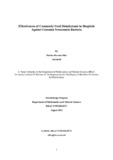Effectiveness of commonly used disinfectants in hospitals against common nosocomial bacteria

View/
Date
2023-08Publisher
Brac UniversityAuthor
Mim, Maisha HossainMetadata
Show full item recordAbstract
Nosocomial infections, commonly acquired during hospital stays, pose a significant threat to
patient safety and increase healthcare costs. The effective use of disinfectants is crucial for
decreasing the transmission of nosocomial bacteria in healthcare settings. This thesis paper
aimed to evaluate the effectiveness of various commonly used disinfectants in hospitals against
4 most common nosocomial bacteria (Staphylococcus aureus, Escherichia coli, Klebsiella
pneumoniae, and Acinetobacter sp. ), providing valuable insights for infection control
practices. In this study, swab samples were collected before and after the application of
disinfectants from two government hospitals and two private hospitals. The surfaces selected
for sampling included the operating table in the operation theatre and the floors of the wards,
as these areas are where patients typically spend most of their time. The disinfectants that were
used during this study were Savlon, Hexisol, Clotex, Shinex, and Perfume Phenyle. Two types
of samples were collected from each area: one before and one after the application of
disinfectants for surface cleaning. S. aureus, E. coli, K. pneumoniae, and Acinetobacter sp.
were isolated from the collected samples using selective media. Samples were then subjected
to serial dilution to find the effectiveness of the disinfectants. The decrease in the number of
microbes before and after surface disinfection was quantified using log reduction. The highest
log reduction was Perfume Phenyle in the case of the ward as it was able to achieve a 100%
reduction percentage. Clotex on the other side was able to only kill 50% of the microbes. In
the case of operation theatre, Hexisol was the most effective one with a 100% reduction
whereas Clotex was not effective at all as it had a 0% percentage reduction. After that, the
isolates were tested for non-susceptible testing, where different concentrations of the
disinfectants were applied to determine the zone of inhibition. The inhibition zones were
measured to compare the resistance rate of the disinfectants. The results indicated that Shinex
and Savlon exhibited strong inhibitory effects on the growth of the isolates, even at reduced
concentrations (60% of their concentrations). Conversely, Perfume Phenyle demonstrated
more resistance, with minimal or no inhibition zones observed even at the recommended
concentration. Hexisol showed comparatively higher resistance even when its high
concentrations were used and no concentration was observed to be resistant less than 50% in
any concentrations. Whereas, Clotex works up to 90% of its concentration. Among the tested
microbes, S. aureus displayed less resistance than the others, even at lower concentrations of
disinfectants. In conclusion, this study highlights the varying efficacy of different disinfectants
against nosocomial bacteria. Shinex and Savlon demonstrated notable effectiveness, while
Perfume Phenyle exhibited no efficacy. These findings provide valuable insights into the
selection and utilization of disinfectants for effective infection control in healthcare settings.
